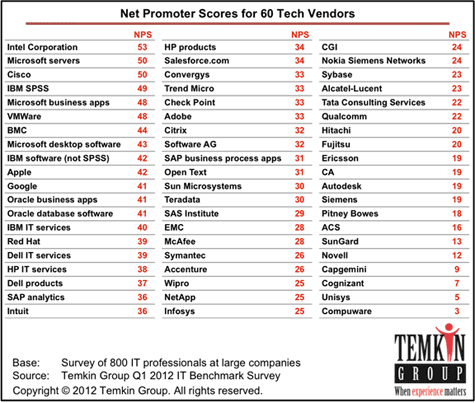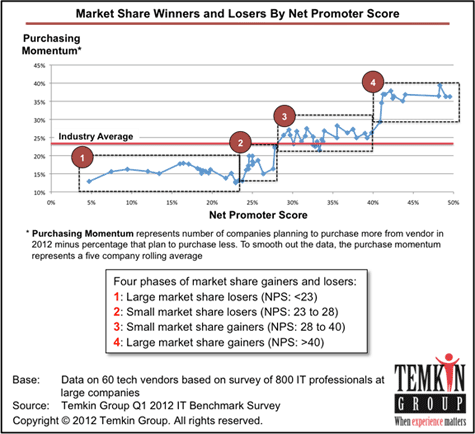Using Net Promoter Score to Improve Customer Experience
Page Contents
By Bruce Temkin, Managing Partner, Temkin Group
In case you don’t know about Net Promoter Score (NPS), it’s a metric that’s based on a simple question to customers: How likely are you to recommend <COMPANY> to a friend or colleague?
In its standard form, respondents choose an answer in the range from “0” (not at all likely) to “10” (extremely likely). Based on the response, customers are classified into one of three buckets:
Promoters (selected “9” or “10”)
Passives (selected “7” or “8”)
Detractors (selected “6” or less)
NPS is calculated as the percentage of Promoters minus the percentage of Detractors. So NPS is a score that can range from -100 percent to +100 percent. A positive score means a company has more Promoters than Detractors.
One of the most powerful components of NPS is its simplicity. Not only is it a straightforward question, but it uses a very simple language to describe customers: Promoters, Detractors, and Passives.
A Look at NPS Scores for Tech Vendors
Temkin Group recently surveyed 800 IT decision makers from large companies and asked them to rate tech vendors on the NPS scale. Here is the NPS for 60 technology vendors. The scores range from Intel, Microsoft and Cisco with NPS in the 50s, down to Compuware, Unisys, Cognizant and Capgemini that have scores below 10.

Why Does NPS Matter?
Companies that use NPS believe it is correlated to loyalty. If you raise your NPS score, you will increase customer loyalty and, therefore, improve your business. If you look through the academic and market research literature, you will find strong supporters of this notion and equally strong positions from people who do not believe that this connection has been proven.
We asked the IT professionals how much their company was planning to spend on each vendor and mapped this data with NPS. To identify a single spending score, we created a “purchasing momentum” index equivalent to the percentage of responding companies that plan to buy more in 2012 minus the percentage that were planning to spend less.

We found four bands of performance in this market based on NPS scores:
More than 40: These companies have much higher purchase momentum and are poised to grab considerable market share
Between 28 and 40: These companies have above average purchase momentum and are poised to gain market share
Between 23 and 28: These companies have below average purchase momentum and are poised to lose market share
Less than 23: These companies have much lower purchase momentum and are poised to give up a lot of market share
Secret to NPS Success – Work at It
For the customer segment we studied — IT buyers in large companies — tech vendors can improve customer loyalty if they can improve their NPS scores across the performance bands. But how can they do that?
Many companies use Net Promoter Score (NPS) as a key metric. But the measurement, although touted as ”The Ultimate Question,” is not a panacea for improving customer experience. The success of NPS comes less from the question and more from the program that is built around the insights that it can generate.
Make sure you ask the right portfolio of questions of the right clients at the right time so you can understand why they are Promoters, Detractors or Passives. If you understand the drivers, then you can build a closed-loop voice of the customer program to improve your business, which will result in a higher NPS and hopefully create more loyal customers.
Bruce Temkin is a customer experience transformist and managing partner of the Temkin Group. He is also chair of the Customer Experience Professionals Association and writes for the Customer Experience Matters blog.

Drew Robb is a writer who has been writing about IT, engineering, and other topics. Originating from Scotland, he currently resides in Florida. Highly skilled in rapid prototyping innovative and reliable systems. He has been an editor and professional writer full-time for more than 20 years. He works as a freelancer at Enterprise Apps Today, CIO Insight and other IT publications. He is also an editor-in chief of an international engineering journal. He enjoys solving data problems and learning abstractions that will allow for better infrastructure.